

Agalmatophilia. Clinical study[edit] Agalmatophilia became a subject of clinical study with the publication of Richard von Krafft-Ebing's Psychopathia Sexualis.

Krafft-Ebing recorded an 1877 case of a gardener falling in love with a statue of the Venus de Milo and being discovered attempting coitus with it.[2] Fantasy, transformation, role-play[edit] An important fantasy for some individuals is being transformed into the preferred object (such as a statue) and experiencing an associated state of immobility or paralysis. Such fantasies may be extended to role-playing, and the self-coined term used by fetishists who enjoy being transformed into what appears to be a "rubber doll" or "latex doll". Hypoxia (medical) Apophenia. Apophenia /æpɵˈfiːniə/ is the experience of seeing patterns or connections in random or meaningless data.
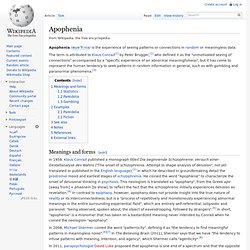
The term is attributed to Klaus Conrad[1] by Peter Brugger,[2] who defined it as the "unmotivated seeing of connections" accompanied by a "specific experience of an abnormal meaningfulness", but it has come to represent the human tendency to seek patterns in random information in general, such as with gambling and paranormal phenomena.[3] Meanings and forms[edit] In 2008, Michael Shermer coined the word "patternicity", defining it as "the tendency to find meaningful patterns in meaningless noise".[6][7] In The Believing Brain (2011), Shermer says that we have "the tendency to infuse patterns with meaning, intention, and agency", which Shermer calls "agenticity".[8] Intuitionism. In the philosophy of mathematics, intuitionism, or neointuitionism (opposed to preintuitionism), is an approach where mathematics is considered to be purely the result of the constructive mental activity of humans.
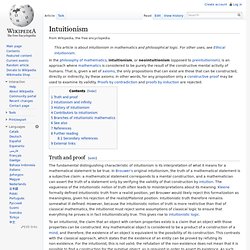
That is, given a set of axioms, the only propositions that can exist are those that can be constructed, directly or indirectly, by these axioms. In other words, for any proposition only a constructive proof may be used to examine its validity. Proofs by contradiction and proofs by induction are rejected. Truth and proof[edit] To an intuitionist, the claim that an object with certain properties exists is a claim that an object with those properties can be constructed. Gunk (mereology) In mereology, an area of philosophical logic, the term gunk applies to any whole whose parts all have further proper parts.
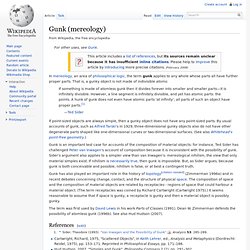
That is, a gunky object is not made of indivisible atoms: If something is made of atomless gunk then it divides forever into smaller and smaller parts—it is infinitely divisible. Fad. Pet rocks were a short-lived fad in the 1970s.

Deltiology. A postcard collection Deltiology (from Greek δελτίον, deltion, diminutive of δέλτος, deltos, "writing tablet, letter"; and -λογία, -logia) is the study and collection of postcards.

Professor Randall Rhoades of Ashland, Ohio, coined a word in 1945 that became the accepted description of the study of picture postcards.[1][2] It took about 20 years for the name to appear in the dictionary the first time.[1] Compared to philately, the identification of a postcard's place and time of production can often be an impossible task because postcards, unlike stamps, are produced in a decentralised, unregulated manner. For this reason, some collectors choose to limit their acquisitions to cards by specific artists and publishers, or by time and location.
Identification[edit] There are some general rules to dating when a postcard was printed.[3] Postcards are generally sent within a few years of their printing so the postmark helps date a postcard. Compulsive hoarding. Compulsive hoarding in an apartment.
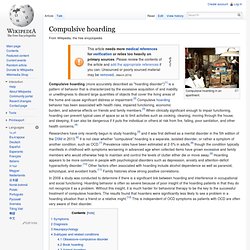
Compulsive hoarding (more accurately described as "hoarding disorder")[1] is a pattern of behavior that is characterized by the excessive acquisition of and inability or unwillingness to discard large quantities of objects that cover the living areas of the home and cause significant distress or impairment.[2] Compulsive hoarding behavior has been associated with health risks, impaired functioning, economic burden, and adverse effects on friends and family members.[3] When clinically significant enough to impair functioning, hoarding can prevent typical uses of space so as to limit activities such as cooking, cleaning, moving through the house, and sleeping. It can also be dangerous if it puts the individual or others at risk from fire, falling, poor sanitation, and other health concerns.[4] In 2008 a study was conducted to determine if there is a significant link between hoarding and interference in occupational and social functioning.
Phylogenetic tree. In a rooted phylogenetic tree, each node with descendants represents the inferred most recent common ancestor of the descendants, and the edge lengths in some trees may be interpreted as time estimates.
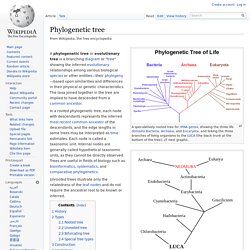
Each node is called a taxonomic unit. Internal nodes are generally called hypothetical taxonomic units, as they cannot be directly observed. Trees are useful in fields of biology such as bioinformatics, systematics, and comparative phylogenetics. Unrooted trees illustrate only the relatedness of the leaf nodes and do not require the ancestral root to be known or inferred. History[edit] Charles Darwin (1859) also produced one of the first illustrations and crucially popularized the notion of an evolutionary "tree" in his seminal book The Origin of Species. Consortium for the Barcode of Life. The Consortium for the Barcode of Life (CBOL) is an international initiative dedicated to supporting the development of DNA barcoding as a global standard for species identification.
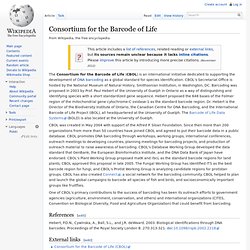
CBOL's Secretariat Office is hosted by the National Museum of Natural History, Smithsonian Institution, in Washington, DC. Barcoding was proposed in 2003 by Prof. Paul Hebert of the University of Guelph in Ontario as a way of distinguishing and identifying species with a short standardized gene sequence. Hebert proposed the 648 bases of the Folmer region of the mitochondrial gene cytochrome-C oxidase-1 as the standard barcode region.
Dr. Sequential hermaphroditism. Sequential hermaphroditism (called dichogamy in botany) is a type of hermaphroditism that occurs in many fish, gastropoda and plants.
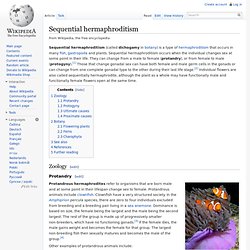
Sequential hermaphroditism occurs when the individual changes sex at some point in their life. They can change from a male to female (protandry), or from female to male (protogyny).[1] Those that change gonadal sex can have both female and male germ cells in the gonads or can change from one complete gonadal type to the other during their last life stage.[2] Individual flowers are also called sequentially hermaphrodite, although the plant as a whole may have functionally male and functionally female flowers open at the same time. Zoology[edit] Protandry[edit] Protandrous hermaphrodites refer to organisms that are born male and at some point in their lifespan change sex to female.
Other examples of protandrous animals include: The ctenophore Coeloplana gonoctena. Aposematism. Aposematism (from Greek ἀπό apo away, σ̑ημα sema sign, coined by Edward Bagnall Poulton[1][2]), perhaps most commonly known in the context of warning coloration, describes a family of antipredator adaptations where a warning signal is associated with the unprofitability of a prey item to potential predators.[3] Aposematism is one form of an "advertising" signal (with many others existing, such as the bright colours of flowers which lure pollinators). The warning signal may take the form of conspicuous colours, sounds, odours[4] or other perceivable characteristics.
Aposematic signals are beneficial for both the predator and prey, both of which avoid potential harm. Aposematism is exploited in Müllerian mimicry, where species with strong defences evolve to resemble one another. By mimicking similarly coloured species, the warning signal to predators is shared, causing them to learn more quickly at less of a cost to each of the species.